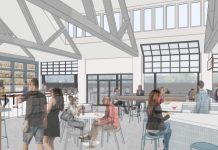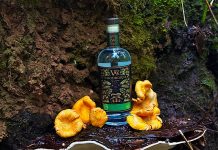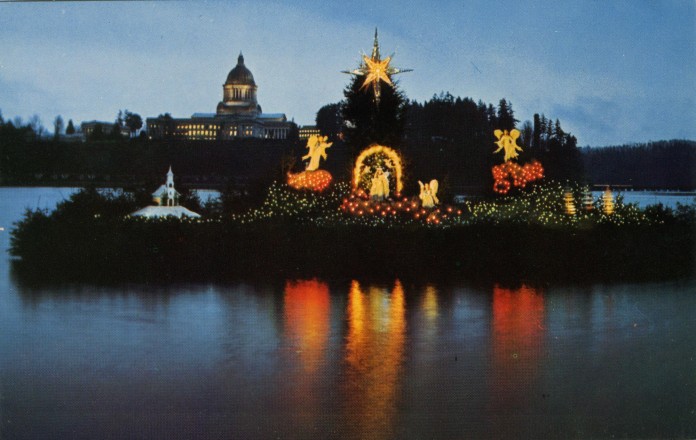 All over the West Coast, December 1941 was dark. In the weeks following the attack on Pearl Harbor, cities up and down the coast observed blackouts in preparation for what was thought to be an imminent Japanese attack.
All over the West Coast, December 1941 was dark. In the weeks following the attack on Pearl Harbor, cities up and down the coast observed blackouts in preparation for what was thought to be an imminent Japanese attack.
But, Olympia’s most famous Christmas display came to life that month.
Since September, Leonard Huber had been toiling to create a lighted display for a later cancelled contest. But, on the two week anniversary of Pearl Harbor, Huber lit his display (which he had named “Peace on Earth” prior to the attacks) for one night only.
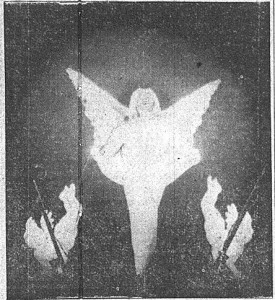
More that 5,000 people came by his modest house at the corner of Fairview and 11th on the crest of the Eastside hill on that Sunday. Many, he reported to the newspaper, dropped to their knees. And, the people kept coming, well into Monday morning.
For the next four years of the war, Huber kept his lawn unlit. But, in 1946, the first Christmas after a full year of peace, Huber’s display came back. That year, more than 10,000 people snaked through the Eastside streets to find nativity scene, miniature church, angels, shepherds and wise men.
That first year back from the war, the display also suffered its first destruction by fire. Just a week into 1947, an “overheated stove” sparked a fire that destroyed much of the display. But, as he always would, Huber rebuilt and got the display ready for the next year.
That next winter, it really started getting crazy.
On the Saturday and Sunday nights before Christmas 1947, more than 45,000 people came through to see the lights in his yard.
Olympia’s one on duty police officer, and almost inexplicably, a realtor who described himself as “Olympia’s one man chamber of commerce” took control of traffic through town. The two men rerouted traffic one way through the Eastside, trying to find a way for everyone to see the display.
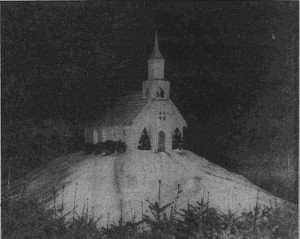
In those years, Huber began depending on outside organizations, like the Jaycees and the Chamber of Commerce, to fund his displays. He and a few others even set up a “Sacred Scenes” organization to raise monies to support Huber.
The massive display at his house lasted two more Christmas seasons, with the Olympia police taking a more hands-on stance to routing traffic through the neighborhood.
The way to Huber’s house from the Pacific Highway (this is years before Interstate 5 would be built) was not a straight shot. His section of Fairview did not connect to the rest of the neighborhood, so traffic would snake through a few turns after leaving the main city thoroughfare.
In 1950, his neighbors and civic leaders apparently had had enough, and Huber took his display north to Tacoma’s Point Defiance Park. That city’s Junior Chamber of Commerce underwrote the display and it marked nearly a decade of exile for the Sacred Scenes.
During the 1950s, Huber’s Sacred Scenes would pop up at a drive-in theater along the Duwamish River and a cemetery in North Seattle.
But, in 1959, Huber made a glorious return to Olympia. Jointly supported by the finances of Olympia’s business community and the manpower of the U.S. Army Corps of Engineers, the original Sacred Scenes transformed into Christmas Island.
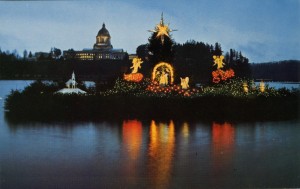
Christmas Island floated in Capitol Lake during the holiday season. It reached nearly 300 feet in length, featured a stainless steel cross 16 feet across and weighing a ton, a nativity scene, and thousands of lights.
After only three years floating on Capitol Lake, the display burnt again. After being stored for the season, the entire display went up in flames, forcing Huber and his supporters to skip the 1963 season. Similar to the early 1940s, an organization grew up around the display to provide financial support.
When Christmas Island was floated again in 1964, it became more a peninsula after the Army dropped their support, forcing the display onto a couple of permanent docks for at least a couple of seasons.
Huber’s Christmas Island found its way back afloat on an island and stayed on Capitol Lake until 1982, but not uninterrupted. Aside from the one year erased by fire, Christmas Island spent at least one winter floating off of Boston Harbor in the mid 1970s.
It is a unclear why the display moved from Capitol Lake to the mall, but Huber was involved in a lawsuit with the Christmas Island support organization over ownership.
But, South Sound Center, or rather in a stormwater pond behind Sears, was where Christmas Island stayed through the mid-1990s until the Huber family decided to keep the legacy alive by displaying the major elements at Hubers Gasthaus.
Finally, in 1998, portions of the Christmas Island display returned to the Eastside when the then Olympia Metro Church on Puget Sound put up the display. Then, in 2008, three years after Huber himself passed away, Christmas Island was put back into storage one more time.
Then, in 2012, Christmas Island was resurrected from storage, this time by the Maytown Assembly of God, which has displayed most of the major elements of Christmas Island.
Christmas Island is on display every night, after dark, through January 1. Warm drinks and snacks are available during weekends. Donations are accepted year-round. You can find the display at Maytown Assembly of God at 2920 Tierney St. SW in Olympia.





